LNG Proposal – Neighbors Concerns
Columbia River Basin
|
NEW ESRI StoryMaps: What's On Our Shelves & NWNL Song Library & No Water No Life ESRI |
Columbia River Basin
George Exum
Affiliated with Columbia River Business Alliance
Dan Seers
Affiliated with Columbia River Clean Energy Coalition and Columbia River Keeper
Vonda Brock
Sixth-generation Puget Island resident
Frans Eykel
Affiliated with Friends of Living Oregon Waters
Kristen Lee
LNG Coordinator for Oregon’s Sierra Club
David Sevres
Puget Island resident
Alison M. Jones
NWNL Director and Photographer
Bonnie Muench
Photographer, Artist & Book Designer
In 2007, Columbia River’s Puget Island was one of many communities in 2007 protesting a proposed pipeline to carry LNG (liquefied natural gas) along the Lower Columbia River and across their land, forest and wetlands. A plan for a 55-acre receiving terminal was sited at Oregon’s Bradwood Landing on the south bank of the Columbia River, 22 miles upriver above Astoria. There, tankers coming in from the Pacific could convert their liquid fuel back into gas to be sent across Oregon via a pipeline.
This project at Bradwood Landing, a former lumber town, was approved in 2008 by FERC (Federal Energy Regulatory Commission), but not the State of Oregon, where local environmental groups led by Columbia Riverkeeper decried the project’s threats, including dredging salmon habitat. In 2010, the funders’ bankruptcy ended the project.
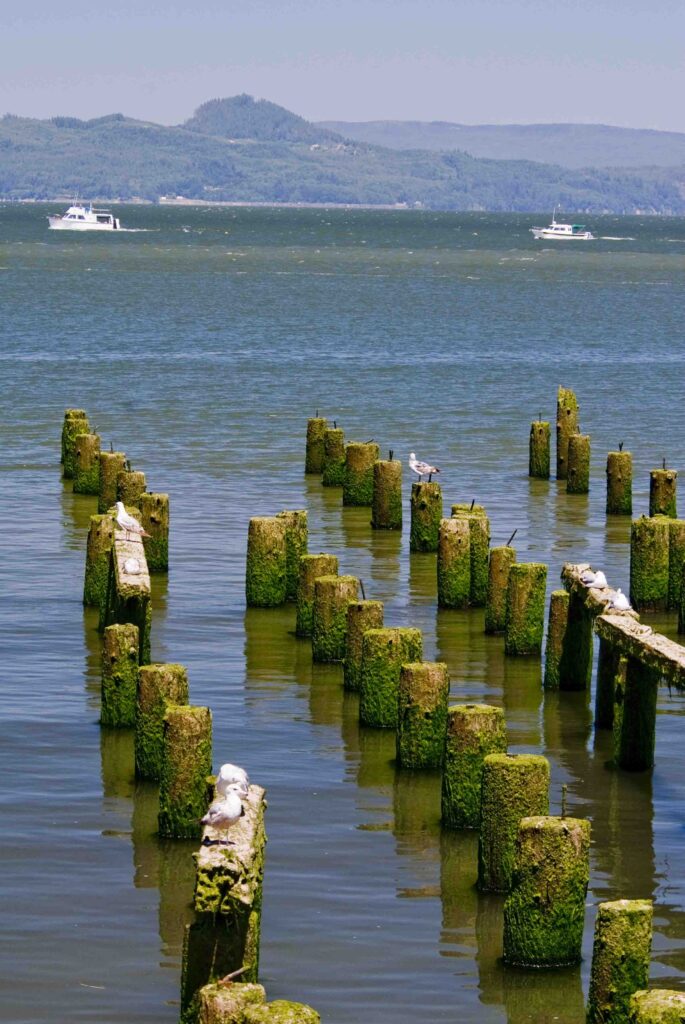
LOCAL & REGIONAL RESISTANCE
A PROTEST BIGGER THAN “NIMBY”
STATES RIGHTS v FEDERAL GOVERNMENT
SAFTEY ISSUES: NON-ODORIZED GAS & SLIPPAGE
A DEEPLY ROOTED COMMUNITY v GOLIATH
SUPPORT of MANY STEWARDSHIP GROUPS
QUALITY of LIFE
UNCERTAIN FUNDING for LNG’S
Per government statistics, several formal documents and the federal government GAO report regarding LNG spills, there could be a vapor cloud that would burn up to 3 miles from a spill. Some people say much further…. It would burn anyone within a mile within 30 seconds. Any kind of accident would threaten life, property and the environment. – George Exum
“The population doesn't count.” They're trying to say there's not enough people here to be concerned about, they're expendable. – Vonda Brock
All images © Alison M. Jones, unless otherwise noted. All rights reserved.
NWNL Dan, thank you for introducing me to your island community off the north bank of the Columbia River. Please introduce yourself by sharing your background and involvement in stewardship of the Lower Columbia River.
DAN SEERS I work with the Columbia River Clean Energy Coalition and Columbia River Keeper – a group of groups concerned with liquefied natural gas development here in the Lower Columbia River. Their current focus is on fighting 4 proposals to import huge amounts of natural gas in liquefied form.
Our home here on Puget Island is less than a mile from the fast-moving Bradwood Landing Proposal. A Texas company called NorthernStar wants to build a very large receiving terminal to bring liquefied natural gas tankers 38 miles up the Columbia River to here. They want to construct a pipeline for liquified gas in re-gasified form to send out as natural gas to the West Coast. California, which uses a lot of natural gas compared to Oregon and Washington, is the primary driver behind all of this.
A huge array of issues that come with these developments have united people who traditionally don’t agree on environmental or community issues. This has brought together landowners, fishermen, local businessmen, real estate agents, people concerned over shipping on the river and a huge array of environmentalists.
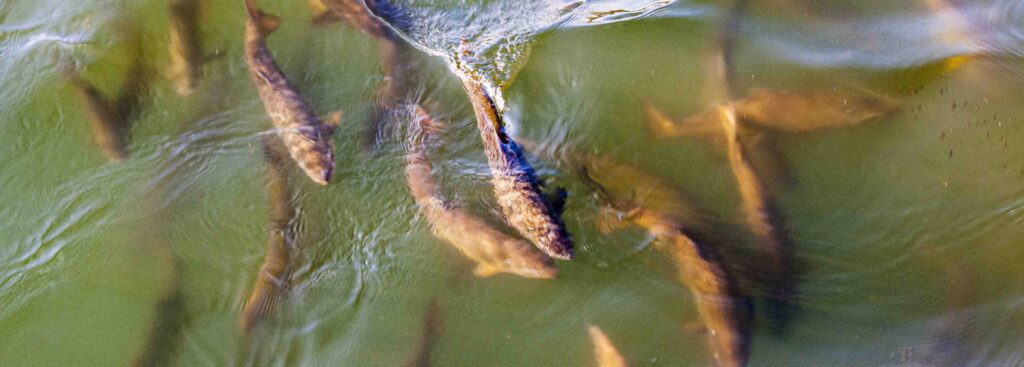
Their fundamental perspectives range from residents living here to an outside company imposing inappropriate development on this area. The project poses huge regional implications for the Columbia River’s salmon and shipping, as well as its economic, environmental and social roles as a vital resource.
NWNL What is this LNG proposal’s biggest threat if it goes through, in your opinion?
DAN SEERS There are many aspects that pose threats. The 2 big issues for m are:
But probably the most offensive part is handing the river over to an energy company with no stake in the community. This company’s goal is to pipe gas across the region to get a high price. But we don’t need that gas here in the Northwest.
NWNL Is there any required accountability?
DAN SEERS Some. The arrogance of the company is they think they can push their project through by throwing a bit of money into the community. The State of Oregon asked them to guarantee upfront all necessary safety and security measures for the river. The company then asked the federal government to disregard that request; and the federal government is notorious for approving these projects. They also know that the federal level is unlikely to adequately oversee the process. Thus, we are seeking as many roadblocks as possible and building as much opposition as possible.
NWNL What stage is the proposal at now? How close to becoming a reality is the project today? And what must happen between now and then?
DAN SEERS We’re laughing because the company says they’ll begin construction three months from now! That’s not likely to happen. They’re still trying to get local landings permits. We hope they will fail on Tuesday in what we expect will be a very controversial hearing.
That hearing is across the river in Astoria; and it will be the local Clatsop County planning commission. Whether they’re soliciting them, they will solicit and receive comments from people here on this island and further upriver from people probably more directly impacted by the project than anyone in Oregon. At this early stage of permitting, Bradwood Landing Project doesn’t have the permits they need. But, nevertheless, they’re telling people, particularly their investors, that they are further along than they are. We’re trying to publicize the facts so they don’t get their permits.
NWNL George, it seems you’ve turned your birthday party today into a rally to get your friends together to pursue this LNG pipeline issue. When did you first focus on this threat?
GEORGE EXUM I’ve lived on this island for 30 years and raised my family here. Almost 3 years ago, coming back from vacation, we saw a little road sign with the letters “LNG” crossed out. Surprised I didn’t know about a proposed LNG plant, we stopped to chat with a nearby homeowner. That was the start of my involvement in this cause.
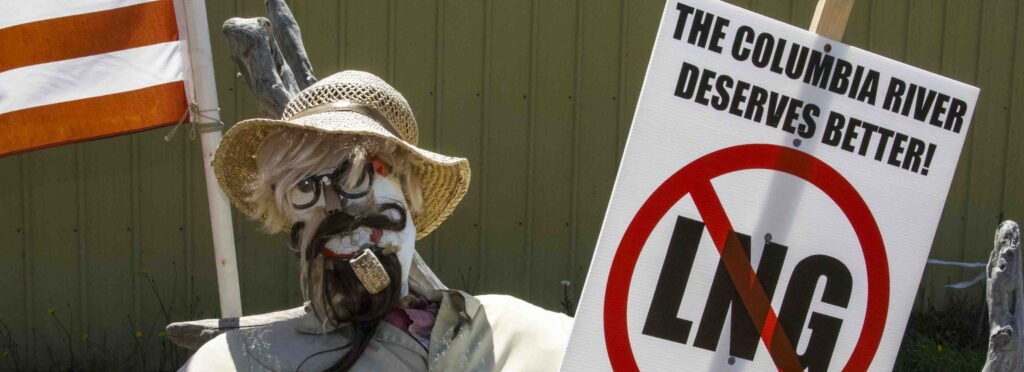
Originally, this would have been a NIMBY issue [“Not In My Back Yard”]. But I’ve put my time into this on a daily, weekly and monthly basis. I’ve learned much more about LNG than I ever wanted to know – how it’s imported, how much it costs, how much the U.S. uses, how much foreigners use, where it goes, where it’s made and how its liquefied. I quickly found this is a complex economic issue, as well as environmental.
Part of our fight is based on economics. There’s no economic sense for LNG to be in this region. Plus, there is complex array of environmental and eminent domain issues. As Vonda will explain, they can take over people’s property to put a pipeline through it. But environmentally, it is absurd to bring an LNG gas tanker up the Columbia.
Plus, they propose dredging 55 acres of prime salmon migratory paths and juvenile rearing habitat. Yes, they have a list of mitigation proposals, but no one knows whether they’ll be effective. However, once they do the dredging, the damage is done. That whole area will be lost forever.
My background is in marine engineering. I was a Chief Engineer on ocean-going ships. I’ve become more and more concerned about all aspects of this project and am convinced it doesn’t fit here. Yes, ships can safely be brought up the river – but all it takes is one unexpected catastrophe….
NWNL What would such a catastrophe be, specifically?
GEORGE EXUM It could be a ship collision; it could be a grounding; or, as the federal government says, it could be a terrorist attack. Homeland Security’s list of concerns includes such LNG facilities and ships as targets worldwide, not just in the U.S.
NWNL What would the effects be if a collision or other catastrophe causes a spill?
GEORGE EXUM The effects could be catastrophic. An LNG spill would suddenly expose a liquid that’s cooled to minus 260º. Here the spill would be on water, creating a pool that starts vaporizing rapidly and turning back into its gaseous state. If, when or where there is an ignition source, it will burn.
There could be a vapor cloud that would burn up to 3 miles from the spill, per government statistics, most scientists, several formal documents and now the federal government GAO report regarding LNG spills. Some people say the vapor cloud would burn much further than 3 miles. Within 30 seconds, it would burn anyone within a mile. Any kind of accident would severely threaten life, property and the environment.
NWNL What is be the probability or possibility of that happening?
GEORGE EXUM The probability is low. But it is higher than if we didn’t have the plant.
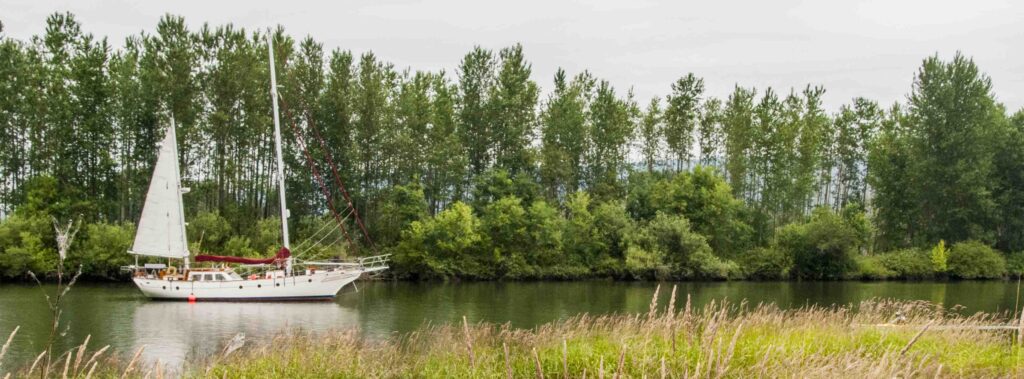
GEORGE EXUM This should be sited where their major market is – which is California.
NWNL Then why aren’t they siting it in California, instead of up here?
GEORGE EXUM From the 1970s, California has been very successful in fighting such facilities. But in 2005 the federal government gave the Federal LNG Regulatory Commission [FLNGR] the power to overrule states’ rights on energy issues. Prior to that, states could stop these things. Since California had been so successful in fighting them, it got federal preemption.
Loretta Lynn, former head of California’s Public Utilities Commission [PUC] and an advocate for affordable clean energy, has been involved in our cause. She spoke at an Environment Justice Conference in Eugene last spring. Using Federal Government statistics, she says this gas is better for California.
When this Bradwood Project first started, it went through our state’s site approval process. The State of Oregon was much more receptive to our concerns than US Government, particularly the question, “Is there a need for this gas?” People in the gas energy responded, “Oh, there’s a great need.” But we could use their statistics to prove there isn’t a need.
Then, when that 2005 federal energy bill passed, the state’s role ended.
California, Washington and Oregon are all looking at goals to create clean energy options by 2025, or even 2020. But given the money that these fossil fuel facilities have, we may not reach those goals. By linking to another foreign fossil fuel infrastructure, such as LNG pipelines, we sabotage our clean energy option.
NWNL Vonda, how does this issue affect you as a 6th-generation resident here, as well as other people on this island and in this region?
VONDA BROCK It’s difficult to nail down our concerns regionally because this issue has multiple complications; plus, it touches each and every one of us on a personal level.
For me, the pipeline is issued to go through my land. I don’t want it. I don’t need it. I’m not going to use it. However, it seems it will go through my land because of eminent domain. I can’t stop the pipeline, but I can try to stop the terminal itself to keep my land as lovely as it has been for the last 150 years that it has been in our family.
We’re the 6th generation of people that have kept this property pristine. We respect that heritage and the environment that is a part of that property. We respect that fact and everyone else who lives in our forested areas out here.
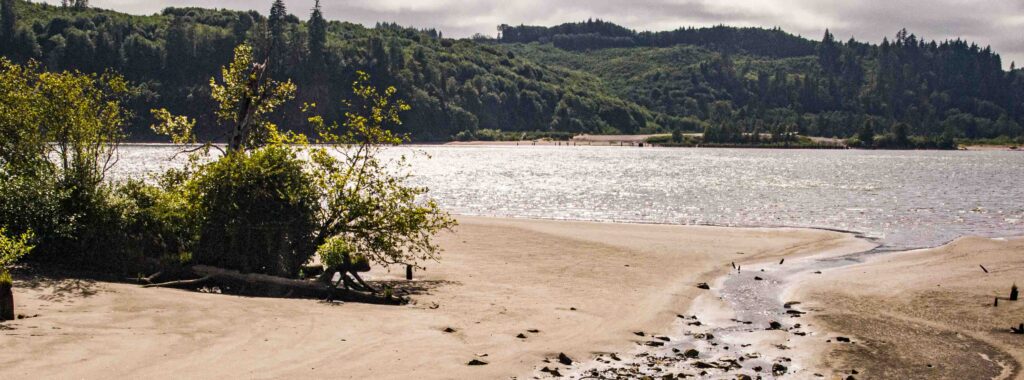
This threat is personal. We each must determine whether we will be safe staying on our property with a 30” pipeline that emits no odor going right past us. I recently asked a man proposing another LNG facility in this area how he could possibly agree to allow 30-inch pipelines to pass people’s homes with no fragrance in the pipeline. Thus, there’d be no way to know there was a leak. He explained they can’t do that because if they odorize the gas, it will create too much Sulphur effluent. To me, that suggests a wider issue, because all existing odor-ized pipelines across the US must have an issue regarding their Sulphur effluent. I don’t know for sure, but it doesn’t make sense.
I realize people all over our country live on pipelines and probably don’t even know it. But if we don’t have it, why should we want it? Again, I don’t want it; and it’s not necessary. It will go through a state that didn’t ask for it and doesn’t want it. It will go through an area that geologically is about as hazardous as could be.
The region from Seattle to Portland is a slip-slide. A few years ago, half of Astoria slipped down the hill. Portland is always losing homes sliding down the hill. That is a regional issue, not block by block. We’ll face this issue if they force this pipeline through areas geologically insensitive to any kind of intrusion.
The pipeline will also affect our water resources, not just our backyards. We feel the Columbia River is our backyard, having run down all the way from Canada and finally nearing the Pacific Ocean. The multiplicity of benefits the Columbia River affords all of us who live on this river and love it far outweighs having a few people making money on oil at the expense of all of us on the Columbia River. It’s ludicrous.
This pipeline is being pushed here Oregon because we don’t have the same influence with legislation that the people of California have. We don’t have Hollywood to back us up. So, we must try harder, fight harder, talk louder and threaten — and that’s what we’re doing.
NWNL To put a human face on this, what brought your family here 6 generations ago?
VONDA BROCK Logging. Our ancestor rode from Vermont to Oregon. Then someone stole his horse, so he walked the rest of the way. Once in Washington, he logged much of the Old Brook timber and put it on “cigar racks” that carried 5 million board feet of timber at a time down the Columbia River. That timber went to San Francisco, until it burned down. So, we have deep roots in this land, deep roots.
In the old days, some went to California to look for gold, and others came to Washington and Oregon to put down roots – and they are still here We are not people who just move from job to job or from place to place…. But now, others looking for today’s “gold” have come in here, trying to weaken those tap roots. This group of communities are made up of people who are grass-roots rich. We’re strong and we’re hardy. We’ll reach out and help anybody. We’re good at that.

NWNL What is today’s population of Puget Island?
VONDA BROCK Somewhere between 800 and 1,000. But even it was only one person, that’s one life that’s equal to all life. Our population count doesn’t count – and that’s what the LNG folks are trying to say. “Their population doesn’t count.” They’re trying to say there’s not enough people here to be concerned about, – that we are expendable. Even one person is not expendable.
NWNL This seems to me to be a “David against Goliath” story, which is why I wanted to ask that question. Franz, what are your roots here?
FRANS HIEGEL I live here on Puget Island, just ½ a mile across from the proposed Bradwood site. We found the island and this county on a Sunday afternoon road trip 44 years ago. We had come to the United States from Holland/ From Los Angeles, we worked our way up north along the coast until we found this dream place. Puget Island reminds us Holland.
NWNL Jumping forward to today, what are your thoughts about the Bradwood Project?
FRANS HIEGEL Like George – lo and behold! – one day I saw the same LNG signs in the front yards. I questioned what they meant, just as George did. We educated ourselves about the issues and chose to actively fight. My main issue is that they will destroy the only unspoiled part of the river – the Lower Columbia from upstream of here to the mouth where it meets the Pacific. They’ll spoil our river with energy facilities that will only attract more energy-hungry industries, like ethanol facilities, paper mills, power-generating facilities, you name it…. Before long we’ll be like Germany’s Rhine River valley, which is just one industry after another. To fight this, we’re going to do everything we must, so they won’t succeed.
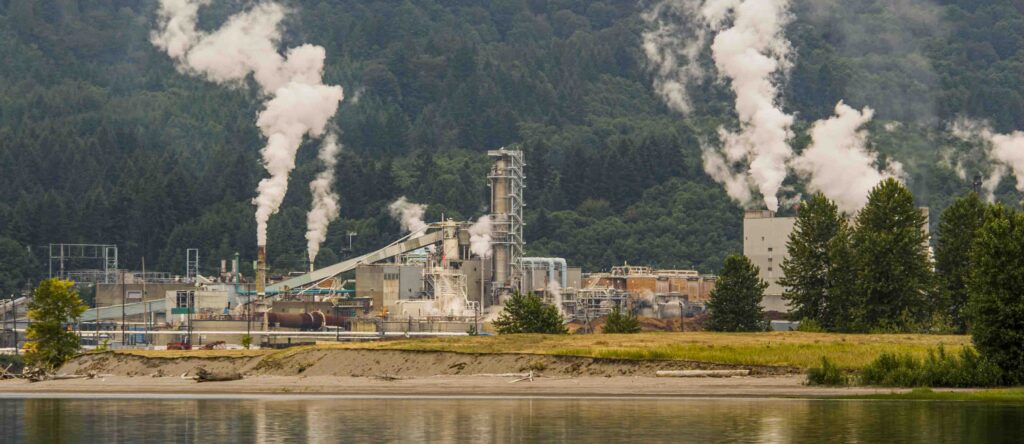
NWNL What specific approaches are you using to fight this?
FRANS HIEGEL Although loosely organized, we write our legislators; we make financial contributions; we attend meetings; we get educated on the issues and we just keep on stalling them. The longer we stall them, the more it will cost these “carpetbaggers,” as I call them. And the more it costs them to build it – because they just borrowed money on the premise of building it – they more likely they’ll never build it. They most likely will sell the permit to the highest bidder and move on. They have no connection with the area and no feeling of the people here.
Another big issue for me is that, according to Congressional records, US taxpayers and rate payers spend $1.5 billion on fish survival in the Columbia watershed. That is paid for with federal money. As well, Oregon, Idaho, and Washington annually spend hundreds and hundreds of millions of states dollars for fish survival, water quality and water management of this river. And yet, the Bradwood Project dares to build a facility here in the most sensitive area of the river, promising approximately $3,000,000 per year to mitigate the harm and destruction they will cause in this estuary.
NWNL Are you working with other river groups to stop this LNG project?
FRANS EYKEL Yes, quite an array of groups are now involved with our Puget Island. Efforts. Friends of the River has organized against this proposal. Columbia River Keeper in Hood River covers the whole river. Friends of Living Oregon Waters, the group that I’m affiliated with, works with many groups throughout Oregon. We’re dealing with a group on Coos Bay, several hundred miles from here but facing very similar issues and their impacts. George is a member of The Columbia River Business Alliance which is organizing against this threat. We’re working with many supportive organizations. Additionally, Portland Audubon and Sierra Club support us. Kristin Lee is our liaison linking the Sierra Club and our Puget Island coalition.
NWNL Kristin, please share your thoughts….
KRISTIN LEE I’m involved with those groups as the Oregon LNG coordinator for Sierra Club. My Puget Island connection is that I purchased a house here in the early 80’s. We just remodeled it a couple of years ago, just as this all started. I first got involved on a small level, and now my commitment has spread to working with a very large, very powerful group of individuals. They are all volunteers, other than some paid attorneys – but not paid enough.
NWNL How would this LNG project affect you personally?
KRISTIN LEE My husband is a fly-fishing guide as well as a fisherman, so we spend a lot of time on the river here. We often fish in the Clifton Channel, right between a wildlife refuge and the proposed site in Bradwood. In spring, hundreds of people come from across a wide area to fish this channel. We were just fishing there the other day and caught a beautiful steelhead trout. It’s a gorgeous natural area.
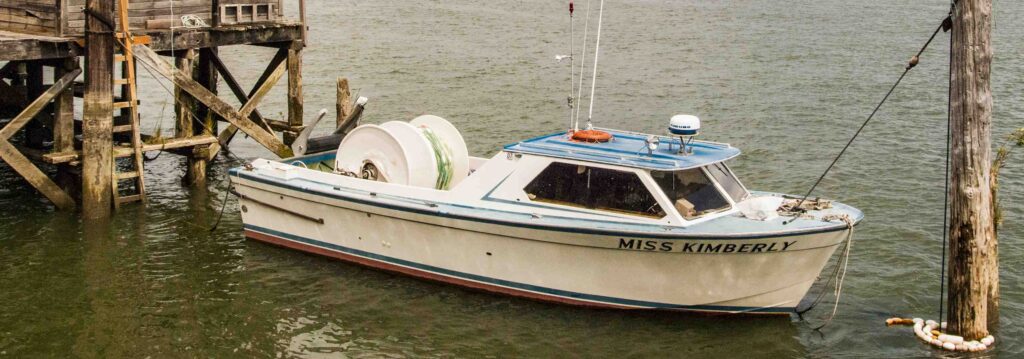
We want this to be our permanent home. Bur our lives have been on hold now for 4 years due to this pipeline issue. I’m a little resentful; but at the same time, I’m determined to see these guys go out the door. I’m positive they will. Our County Planning Commission meeting on Tuesday will get a staff recommendation to stop the zoning changes Bradwood Project wants. That will be a big plus for us and provides the legal opportunity to continue the fight.
Even though we’ve only been a few years in our house here, others have been here for generations. I’m working for them as well for us. I feel badly for these honest, wonderful and hard-working families. They come to your aid no matter what. But their lives will be destroyed because of this. I am very passionate about this. We spend so much time on it, which is very tough on all of us. But we’re going to see it through the end. I think quite soon, we’ll be throwing all our paperwork on this onto a bonfire on the beach.
FRANS EYKEL Yes, we’re hoping!
KRISTIN LEE I’m looking forward to that party!
Meanwhile, everyone’s been very eloquent with what their comments today. We are in the midst of a legal process, as well as a passionate personal process. Much of what the Bradwood proponents tote is the economic boon they will bring to this area. Indeed, people around here worried about jobs for a very long time. But since I’ve been here, I’ve seen such a growth of tourism and many retirees here building beautiful homes. Some of these homes are at least $500,000 in value. But those new-home property owners, as well as those remodeling their homes, like us, use all local resources.
There’s a still a big growth potential here for housing and local tourism such as kayaking. This is a gorgeous estuary where people boat, where people sail, and where people are out on the water all the time. That’s the personal side of my concerns, as well as the regional and the political side that I have.
NWNL We’ve talked here on this lovely porch about NIMBY- not in my back yard. If your Puget Island community succeeds in stopping this pipeline, then what happens? I understand there are three other sites they are considering.
KRISTIN LEE It will be a continuous project. There are two other site proposals that are the front-runners, as well as this. Dan mentioned their focus on Coos Bay along the Oregon Coast. There is also one in Warrenton, next to Astoria, that is moving along full speed ahead. If NorthStar chooses one of those two, our energy will just shift to that one. We’re all committed to fighting this project.
NWNL You’re bound together as a team?
KRISTIN LEE Yes, absolutely. I can see taking a break a little bit, but we’re all going to be involved personally and financially. Coos Bay is an incredible natural area. We are committed to fighting this cause because this is everyone’s back yard. It is the Columbia River.
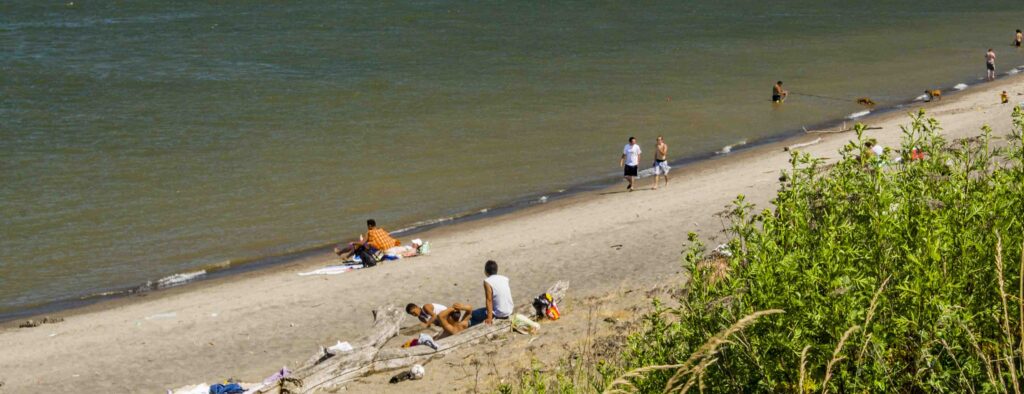
FRANS EYKEL One issue we face is our quality of life. That includes our basically unfettered access to the river, be it commercial, for sport fisherman, boaters and kayakers, or walking your grandchildren on the beach. If one of these sites is chosen, the quality of life, one of the reasons why we all live here, will be shattered for all of us. This would be a military zone. As their LNG tankers come up the Columbia River, we’d see about 5 gun-boats and a helicopter gun ship patrolling.
NWNL Will land be taken out of use for you, or will an access or certain waters that you use be blocked?
FRANS EYKEL It could be. The proponents say, “No.” But look at places like Boston Harbor where, when the ships go in, bridges shut down. If you’re in a restaurant adjacent to the ship’s passage, you can’t leave the restaurant until the ship’s gone by. In Boston, the cost for each ship transit is approximately $80,000, in Federal and State taxpayer dollars.
Approximately $40,000 of that is a federal government expense for the Coast Guard. The rest, be it for sheriffs, police or state troopers, is borne by state and local entities, including divers that must go down to check the dock. All these costs, although spent for a private corporation, are borne by the taxpayers.
FRANS HIEGEL The Rose Parade here in Portland right after 9/11 offers a good example of what you are saying. The Canadian Navy and the U. S. Navy came upriver to participate in the Rose Parade, which they’ve done for many years. I was fishing on the beach with some neighbors and saw all these ships, escorted by gun boats with flashing lights. They challenged every boat on the river and stopped right in front of the beach to look us over with binoculars. I felt like we were in World War III, having barely made it through World War II. So, if we allow LNG or that type of ship traffic on the river, they will militarize and industrialize the river, all at the same time. I won’t stand for it.
VONDA BROCK And if you build one, the rest will come.
FRANS HIEGEL Yes, exactly. It’s bad enough they’re building ethanol plants left and right, here in Longview and Clatskanie, while there is no economic advantage, since it’s a waste now that they can make ethanol from corn.
People have relationships to Puget Island; and they know that a liquefied natural gas facility here, or down in Astoria or in Coos Bay is something foreign. The militarization of the river that will be imposed on us will come from outside and won’t benefit the area. It’s simply foreign. It will come from somewhere else.
NWNL Where will it come from?
FRANS EYKEL That’s an unanswered question at this point. The LNG could come from Indonesia – or maybe Peru, which has massive LNG export facilities. Russia is another possible source, as are places with poor environmental and human rights trafficking. The pain, fear and militarization we could see here is replicated many times over in other places. They give us a window for the Lower Columbia if we don’t stop this proposal.
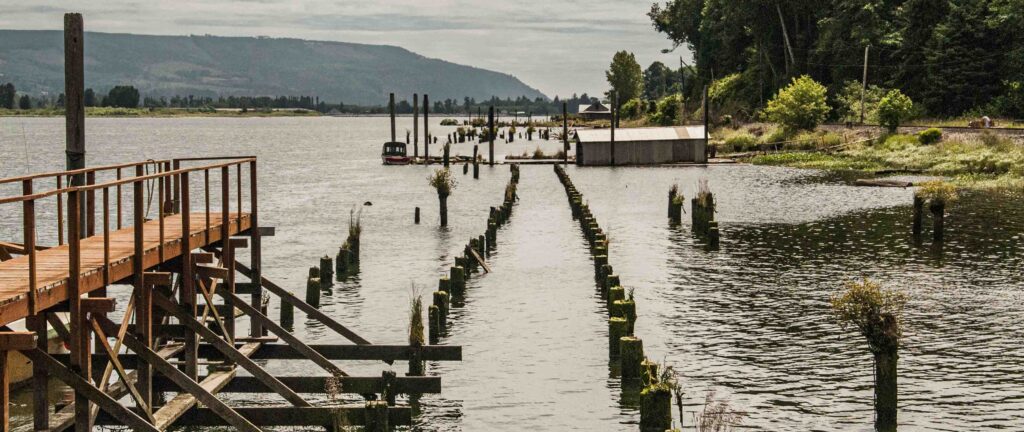
VONDA BROCK LNG comes from destinations where people don’t like Americans. That’s one of the big issues. They don’t like us; and yet we will depend on them if they can habituate us to natural gas. What will that do in the long run? Will we see problems with terrorists? or changes of government? or power changes overseas? Where will we be if we are dependent on LNG coming from where people do not like America?
FRANS EYKEL Those other countries don’t have the protections that we have here. For instance, we have a local landings process to use to fight NorthernStar Natural Gas. Shell and its operations in Russia have done terrible damage to very similar type of ecosystem with fantastic salmon runs in eastern Russia. It’s an incredible story that strongly parallels what could happen here, in terms of destruction by the pipeline and the LNG construction itself. We’ve met with people from that area in Russia. They warning to us to get terms in writing, or don’t build it.
I would probably trust Shell, a multi-billion corporation, much more than this group of Texas energy speculators that really don’t know anything about the Columbia River.
NWNL So Bradwood is being financed through speculation?
FRANS EYKEL Yes, they raised risky funding from an investment firm that specializes in distressed companies. NorthernStar’s proposal was floundering, and then they got a big pulse of money. Any profits go to Matlin Patterson, a New York distressed securities investment firm. [Editor’s Note: This distressed securities fund was founded 2002 and it filed for bankruptcy in 2021.]
NWNL Do residents here know this?
FRANS EYKEL Yes. We’ve picketed their NY headquarters, and we visited them.
FRANS HIEGEL I compare this with the diamond industry. With enterprises in Nigeria and some other third-world countries, we are not profiting. You’ve never heard of these oil companies or LNG facilities they try to build. They don’t have a track record. They just see an opportunity. It’s a damn shame. With BP, Shell or Conoco Phillips, I’m more concerned because they have the money and expertise to cheat ,no matter how big a roadblock we throw up.
NWNL So, this is all an investment?
FRANS HIEGEL It’s a speculation. Some say it’s a hedge fund. The folks doing this will never operate that facility. They don’t have the expertise to build or operate it. In searching their website, we saw their labor unions are very pro-LNG facilities because they are promised 3 years of building facilities and making good money. However, Bechtel, a company that builds such facilities, can’t find enough qualified workers. So, companies like Bechtel hire in the Philippines, in China, or wherever these folks are. They’re not local – or even from within the United States. It’s proven that 15% of those working on LNG facilities being built in Texas and Louisiana are Fillipinos, Koreans and workers with experience through Bechtel.
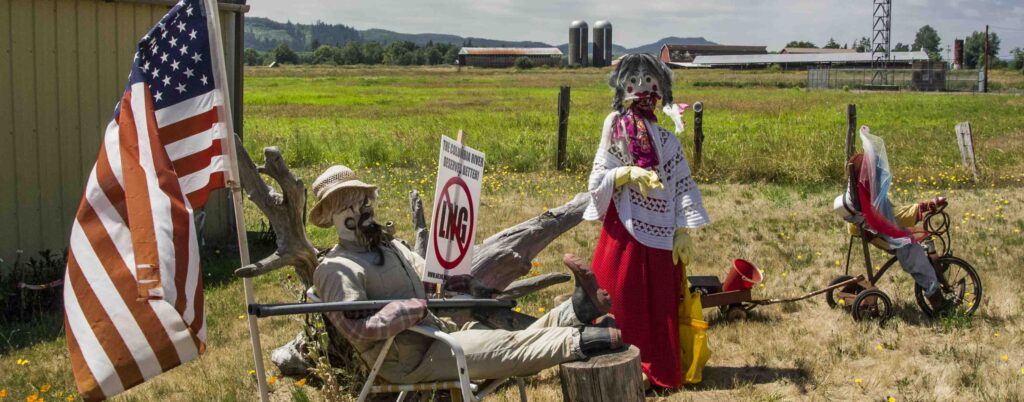
NWNL George, this is your birthday party. Much has been discussed today. Would you please summarize what you feel are the biggest objections to an LNG pipeline running through this Lower Columbia River estuary?
GEORGE EXUM Well, I can narrow it down to an easy, albeit complex, four issues and objections that concern us:
NWNL Good luck to all of you here on Puget Island for explaining your concerns. NWNL wishes you well in your defense of the environment, the river, the salmon, and your family homes and recreation. Thank you all very much.
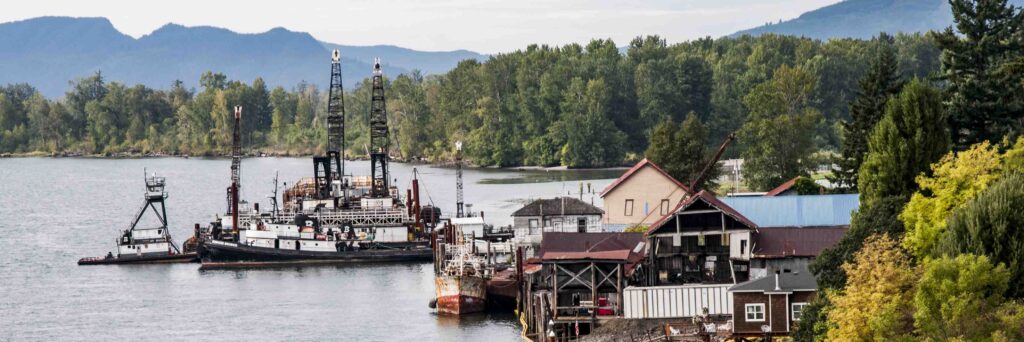
Posted by NWNL on April 7, 2024.
Transcription edited and condensed for clarity by Alison M. Jones.
All images © Alison M. Jones, unless otherwise noted. All rights reserved.
